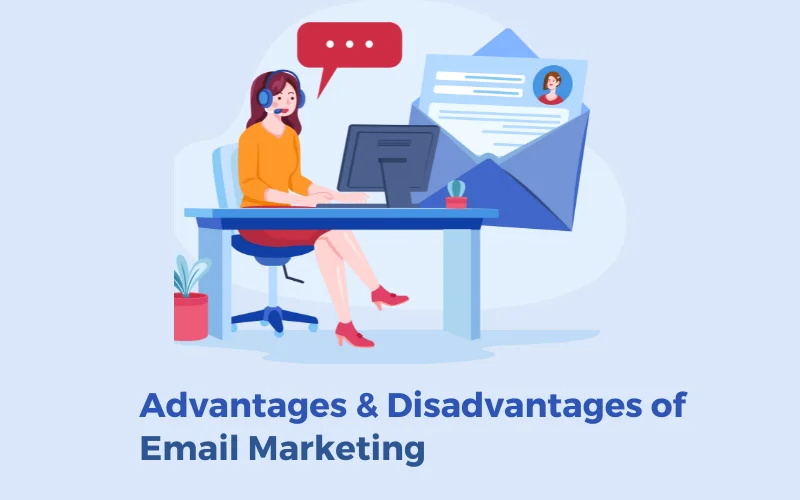Email marketing is one of the most effective ways to reach and engage your audience, but like any strategy, it comes with its own set of challenges. In this post, we’ll explore the advantage and disadvantage of email marketing to help you understand how to maximize its benefits while avoiding common pitfalls. Whether you’re new to email marketing or looking to improve your campaigns, this guide will provide you with the insights you need to succeed.
What Is Email Marketing Used For?
Email marketing is a digital marketing strategy used by businesses and individuals to send messages to a group of people via email. It serves multiple purposes and is one of the most effective ways to connect directly with an audience. Whether you’re a small business owner or part of a large corporation, email marketing can help you build relationships, drive sales, and share valuable information.
Here are some of the most common uses of email marketing:
1. Promotional Campaigns
Businesses often use email marketing to promote products, services, discounts, and limited-time offers. It helps increase sales and traffic to a website or landing page.
2. Newsletters and Updates
Email newsletters are a great way to keep subscribers informed about company news, blog updates, or industry trends. They help maintain engagement and brand awareness.
3. Customer Onboarding and Retention
Email marketing is useful for welcoming new users, guiding them through a product or service, and keeping them engaged over time through targeted follow-up emails.
4. Transactional Emails
These include order confirmations, shipping updates, and payment receipts. Though not promotional, they improve the customer experience and build trust.
5. Surveys and Feedback
Collecting customer feedback through email surveys helps businesses improve their products, services, and customer satisfaction.
6. Re-engagement Campaigns
When subscribers become inactive, email marketing can be used to win them back with special offers or personalized messages.
By understanding what email marketing is used for, you can better evaluate the advantage and disadvantage of email marketing. Knowing its practical applications helps businesses leverage its strengths while being aware of potential limitations.
Advantages of Email Marketing
Email marketing offers several powerful benefits that make it a go-to strategy for businesses of all sizes. Understanding the advantage and disadvantage of email marketing starts with looking at what makes it so effective.
Here are the key advantages of email marketing:
1. Cost-Effective
Unlike print or TV advertising, email marketing is extremely affordable. There are no printing or postage costs, and most email platforms offer budget-friendly pricing plans.
2. High Return on Investment (ROI)
Email marketing consistently delivers a high ROI. According to industry reports, every $1 spent on email marketing can return up to $40.
3. Direct and Immediate Communication
Email lets you reach your audience instantly. Whether you’re launching a new product or announcing a sale, your message is delivered in real time.
4. Personalization and Segmentation
You can tailor emails to individual subscribers based on their interests, behavior, or demographics. This increases engagement and conversion rates.
5. Easy to Track and Measure
With analytics tools, you can track open rates, click-through rates, and conversions. This data helps you refine your strategy over time.
6. Automation Capabilities
Email automation allows you to set up drip campaigns like Mailchimp, welcome emails, and follow-ups—saving time and improving consistency.
7. Builds Long-Term Relationships
By consistently delivering value through email, businesses can build trust and loyalty with their audience.
By leveraging these benefits, businesses can take full advantage of email marketing. However, to get the best results, it’s important to also understand the challenges—which we’ll cover in the next section on the disadvantage of email marketing.
Disadvantages of Email Marketing
While email marketing offers many benefits, it’s also important to understand its drawbacks. Knowing both the advantage and disadvantage of email marketing helps businesses make smarter decisions and avoid common pitfalls.
Here are the main disadvantages of email marketing:
1. Spam and Deliverability Issues
If emails are not properly formatted or permission-based, they may be flagged as spam. Even legitimate emails can sometimes land in the junk folder.
2. Requires a Quality Email List
Email marketing depends heavily on having a clean and targeted list. Building such a list takes time, and sending emails to uninterested users can harm your reputation.
3. Unsubscribes and Low Engagement
If recipients find your emails too frequent, irrelevant, or poorly designed, they may unsubscribe or ignore future messages.
4. Design and Technical Challenges
Creating mobile-friendly, well-designed emails that work across all devices and platforms can be difficult, especially without design skills or tools.
5. Legal and Compliance Requirements
Laws like GDPR and CAN-SPAM require marketers to follow strict guidelines. Failure to comply can result in fines and damaged trust.
6. Over-Reliance Can Backfire
Relying too heavily on email marketing alone can be risky. If open or click rates drop, it may affect your overall marketing performance.
Despite these disadvantages, email marketing remains highly effective when done right. The key is to recognize its limitations and use strategies to overcome them—topics we’ll cover in the next sections.
Best Practices to Maximize the Advantages
To get the most out of email marketing, it’s essential to follow proven best practices. These strategies help you maximize the strengths and reduce the weaknesses tied to the advantage and disadvantage of email marketing.
Here are some key tips to make your email campaigns more effective:
1. Segment Your Email List
Grouping your subscribers based on interests, behavior, or location allows you to send more personalized and relevant content.
2. Write Clear and Compelling Subject Lines
Your subject line is the first thing people see. Make it attention-grabbing but honest to increase open rates.
3. Use Mobile-Responsive Design
Many users check emails on their phones. Ensure your emails look good and function well on all devices.
4. Add Clear Calls-to-Action (CTAs)
Tell your readers exactly what you want them to do—click a link, read a blog post, or make a purchase. Use buttons or bold links for better visibility.
5. Test and Optimize Your Campaigns
Use A/B testing to try different subject lines, images, or layouts. Monitor performance and improve based on what works best.
6. Maintain a Clean Email List
Remove inactive or invalid email addresses regularly. A clean list improves deliverability and engagement rates.
7. Comply with Email Marketing Laws
Always include an unsubscribe option and avoid sending emails to people who didn’t opt in. This builds trust and keeps you legally safe.
By following these best practices, you can enhance the benefits and minimize the downsides associated with the advantage and disadvantage of email marketing. The result is better engagement, stronger relationships, and higher ROI.
How to Minimize the Disadvantages
While email marketing is a powerful tool, it does come with challenges. Fortunately, many of the disadvantages can be minimized with the right strategies. Knowing both the advantage and disadvantage of email marketing helps you take proactive steps to reduce risks and improve performance.
Here are effective ways to minimize the disadvantages:
1. Use Double Opt-In for Better List Quality
Double opt-in ensures subscribers genuinely want to receive your emails. This reduces spam complaints and increases engagement.
2. Regularly Clean and Update Your Email List
Remove inactive, bounced, or fake email addresses regularly to maintain high deliverability and avoid being marked as spam.
3. Create Mobile-Friendly, Well-Designed Emails
Use responsive templates and keep your design clean. Test emails on various devices to ensure they display correctly everywhere.
4. Avoid Spam Trigger Words
Phrases like “Buy now,” “Free,” or “Guaranteed” can trigger spam filters. Write clear, honest, and natural-sounding content.
5. Respect Privacy and Follow Legal Guidelines
Always include an unsubscribe link and follow GDPR, CAN-SPAM, and other applicable laws. Transparency builds trust and keeps you compliant.
6. Send Relevant and Personalized Content
Segment your audience and tailor emails based on preferences or past behavior. Irrelevant emails are more likely to be ignored or flagged.
7. Monitor Campaign Performance
Track open rates, bounce rates, and unsubscribes. This helps you identify what’s working—and what needs improvement.
By addressing these issues early, you can significantly reduce the disadvantages and make your email marketing campaigns more successful. Understanding the advantage and disadvantage of email marketing empowers you to build strategies that maximize effectiveness while avoiding common traps.
Conclusion
Email marketing remains one of the most powerful tools in the digital marketing world. By understanding the advantage and disadvantage of email marketing, businesses can make informed decisions and create campaigns that truly connect with their audience.
The advantages—like cost-effectiveness, high ROI, and direct communication—make it a go-to strategy for marketers. However, it’s equally important to be aware of the challenges, such as spam issues, design limitations, and legal compliance.
The good news is that most disadvantages can be minimized by following best practices—like list segmentation, responsive design, and continuous testing. When done right, email marketing can drive strong engagement, build lasting customer relationships, and deliver impressive results.
In short, knowing both sides of email marketing allows you to use its strengths to your benefit while managing its weaknesses wisely. It’s not just about sending emails—it’s about sending the right message to the right person at the right time.
Related Article




